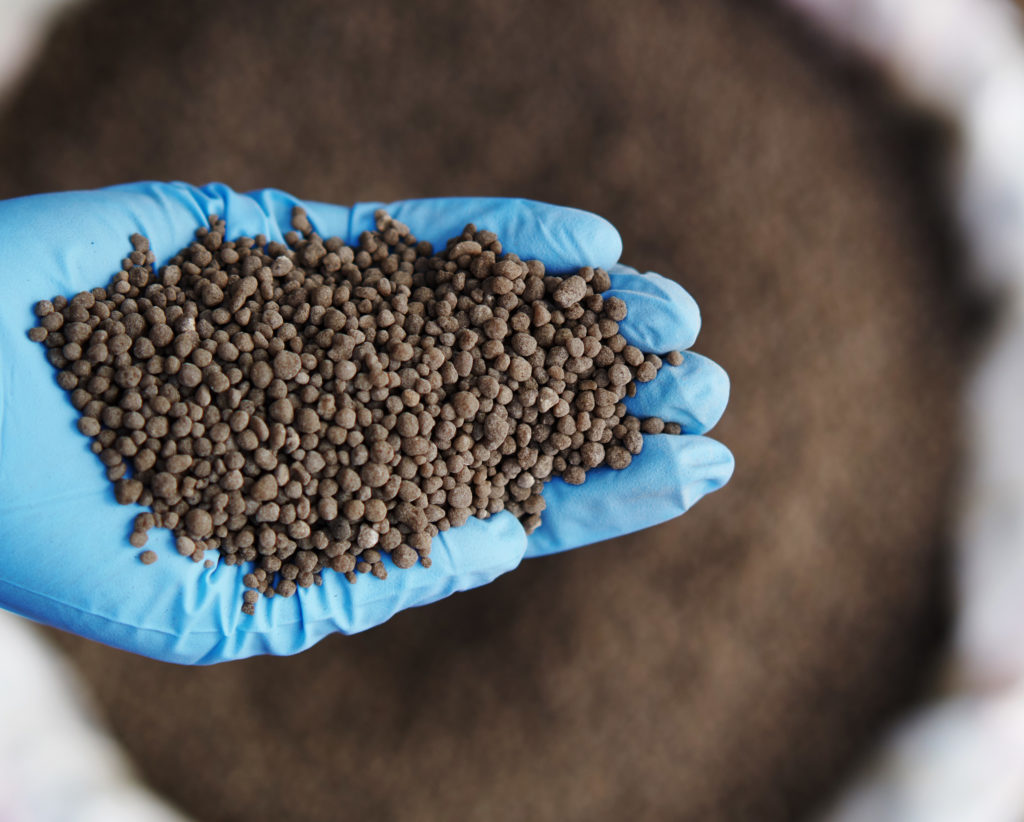The first value we need in order to analyse the data is the emissions resulting from production. ‘Production’ involves all the steps required to produce green coffee ready for export, including growing, processing, and milling. Over the next few lessons, we’ll compare a few different sources of data and identify the major contributions to emissions at this stage, beginning with growing the coffee.
Fertilisers

A pelletised fertiliser
At the farm, the major input, from the point of view of the carbon footprint, is the fertiliser. According to Killian et al.’s study in Costa Rica, it accounts for around 94% of the carbon footprint of this stage of coffee production (B. Killian et al., 2013). By contrast, fossil fuel burning only accounts for only about 3% of emissions at the farm, mainly during transportation of cherry to the wet mill.
Some of the greenhouse gas (GHG) emissions from fertiliser use come from the manufacture of chemical fertilisers, but fertilisers are the main source of emissions even in organic farms. This is because nitrogen in fertilisers that is added to soil and not taken up by plants is converted to N2O, a powerful GHG, by bacteria in the soil.
Organic farms don’t use chemical fertilisers but might use manure or coffee pulp waste as fertiliser, which can release large amounts of N2O in the soil. Organically grown coffee may therefore reduce the emissions generated by fertilisers, but it will not completely eliminate them.
A study comparing different organic and conventional farming systems in Nicaragua and Costa Rica found that the choice between conventional or organic farming had a substantial effect on GHG emissions (MRA Noponen et al., 2012). However, in both systems, the amount of fertiliser used had a big impact on emissions. In fact, the most intensive organic systems produced more emissions than moderately intensive conventional farming. The authors calculate that conventional farming released 0.26–0.67 kg CO2-eq per kilo of fresh cherry, while organic systems released 0.12–0.52 kg.
A significant amount of N2O is also released as a result of pruning. When coffee or shade trees are pruned, the pruning residues are typically left in place to decompose and return their nutrients to the soil. As they do so, they release a significant amount of N2O — enough to make up between 7% and 42% of the carbon footprint of a farm, according to Noponen et al. (2012).
The importance of N2O to the carbon footprint of coffee growing suggests that in both conventional and organic farms, efficient use of nitrogen would be an effective way for farmers to reduce emissions and save money. If farmers apply fertiliser only when plants need it, then more will be taken up by the plant, leaving less to break down in the soil and form N2O. Unfortunately, however, standard life-cycle analysis (LCA) techniques do not include a way to calculate nitrogen use efficiency, and little research has addressed how coffee farmers can most prudently use fertiliser.
Even if choosing organic cultivation doesn’t eliminate emissions from fertiliser, it can still greatly reduce them. Noponen et al. found that 45–50% of the carbon footprint of conventional farming came from the manufacture of fertilisers. A separate LCA carried out on two farms in Tanzania found that production and transport of agrochemicals made up 79% of the carbon footprint of green coffee and 44% of the carbon footprint of a cup of coffee (PCF Pilotprojekt Deutschland, 2008). Another study of robusta farms in Vietnam found that fertilisers account for 85% of emissions on a conventional farm, compared with 68% for organic systems (LTK Trinh et al., 2019).
Which fertiliser is used in an organic system is also important. Poultry manure creates much higher emissions than compost — and nearly as much as chemical fertiliser — because of the amount of N2O released (LD Vera-Acevedo et al., 2016). Where compost is used as an organic fertiliser, a large part of the emissions come from the production of the compost rather than from its application. In this case, improved compost systems such as biodigesters could reduce total emissions from production by up to 38%, according to a study of organic farms in Nicaragua (E Rahn et al., 2012).
Yield and Fertiliser Use
These studies suggest that switching to organic systems or to less-intensive farming could reduce emissions from coffee growing. However, Noponen et al. (2012) caution that because organic systems are less productive, switching to organic farming may result in more land being needed for coffee farming. If the land being turned over to coffee production was previously forest or grassland, the change of land use would result in additional emissions, which are not included in these calculations.
It’s also important to note that less-intensive farming does not always mean less-efficient uses of resources. A study of 116 coffee farms in Mexico, Guatemala, Nicaragua, El Salvador, and Colombia found that the fertiliser-related emissions from low-yielding farms were highly variable, which suggests that more-efficient use of fertiliser in these farms could increase yield and reduce the carbon footprint per kilogram of coffee (H van Rikxoort et al., 2014). ‘Our data suggest that fertilizers were often wasted on the farms of our sample because they were applied to systems whose productivity was limited by other factors, such as light, water, or the age and state of the coffee plants’, the authors write.
In a study of smallholders in Kenya (JJ Maina et al., 2015), the lowest-yielding farms produced the highest emissions per kilo of coffee, even though they used less fertiliser. The average emissions in this study ranged from 3.24 kg CO2-eq per kilo of green coffee for the lowest-yielding farms, down to 0.3 CO2-eq for the highest-yielding farms. In fact, some of the high-yielding farms were so efficient at producing biomass that they actually sequestered carbon. We’ll return to the importance of carbon sequestration in Lesson 2.03.